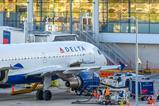After pursuing an aggressive early growth strategy, US start-up carrier Global Crossing Airlines has cooled off on its ambitious fleet-expansion plans.
Global Crossing, which operates as GlobalX, now plans to grow its fleet to 35 aircraft by the end of 2026, rather than its previous goal of eventually operating 50 aircraft, executives revealed during the company’s quarterly earnings call on 6 March.
”We could grow to 50 really fast, but you’ll see what we saw last year where you have to make huge upfront investments,” says president Ryan Goepel. “I’d rather grow through our own cash flow and use positive cash flow, versus outside money.”
“We think getting to 35 is a much more measured and much more achievable growth target,” he adds.

During an investor presentation in November 2023, GlobalX said it was “actively transitioning its fleet towards [an] equal mix between passenger and cargo aircraft, totalling 50 by 2025”.
Last year, the carrier said it had set a goal of growing its fleet to 30 jets by the end of 2024, which now appears unlikely.
GlobalX currently operates 15 Airbus A320-family aircraft, all of which are leased. The carrier expects delivery of another jet as soon as next week.
“We’re taking the aircraft as fast as we can, and we are very comfortable with our ability to put them to work,” Goepel says.
He declined to specify how many aircraft in the carrier’s envisioned 35-strong fleet will be freighters, saying, “I think we’ll let the market tell us what makes sense.”
The comments about more pursuing more measured growth could suggest a strategic shift following the departure of founding chief executive Ed Wegel. Formerly the company’s chief financial officer, Goepel became president following founding CEO Ed Wegel’s resignation in early February.
New executive chariman Chris Jamroz led pre-certification investment in the airline is 2021 and describes himself as a ”very invested shareholder and stakeholder in the success of the business”.
The company reports generating $160 million of revenue during the full year of 2023, up more than 60% from revenue of $97 million during the previous year.
It posted a loss of $20.8 million on the year, compared with a $15.8 million loss in 2022.
Aircraft utilisation was up 26%, year on year.
“This is a key metric for us in the sense that not only are we growing capacity by adding aircraft, we have more frequently been putting more hours on the aircraft every month,” Goepel says.
In 2023, GlobalX flew 18,072 block hours – more than double its total of 8,666 block hours in 2022.
FURTHER OPPORTUNITY
GlobalX launched its first commercial flights in August 2021 and has rapidly expanded both chartered passenger and cargo operations.
The carrier’s cargo arm has recently been focused on matching demand with incoming aircraft deliveries.
“The potential market for freighters in North America is quite massive,” Goepel says. “We still believe the [A321F] is the replacement for the 757.”
More than 350 Boeing 757s are currently egaged in cargo operations in the USA, he notes: “Those will need to be phased out, and that will create a huge opportunity for us,. If you think about the cargo market in the US, it’s all Boeing-based. We’re the first Airbus platform that’s really effectively in the narrowbody space selling cargo.”































